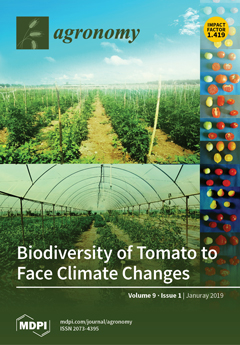Medicago sativa L. is a tetraploid perennial forage legume of great agronomical interest. The increasing need for its use under water-deficit conditions as well as low-input systems demands further improvement of its drought tolerance. On the other hand,
Medicagoarborea L. is a perennial leguminous shrub, which is knownas a drought-tolerant species. In the present study, drought stress responses of the aforementioned medicago species, along with their hybrid, named Alborea, were comparatively assayed at the morphological, physiological, biochemical, and transcriptional levels. In particular, transcript abundance of representative genes that: (a) control ion transport,
intracellular Na+/H+ antiporters(
NHX1) and
rare cold inducible2A (
RCI2A); (b) have an osmotic function
Δ1-pyrroline-5-carboxylate synthetase 1 (
P5CS1); and (c) participate in signaling pathways and control cell growth and leaf function
stress-induced mitogen-activated protein kinases kinases (
SIMKK),
Zinc Finger (
ZFN),
apetala2/ethylene-responsive element binding (
AP2/EREB),
basic leucine zipper (
bzip) and
Medicago sativa Helicase 1(
MH1) were evaluated. Under well-watered conditions, the studied population of Alborea showed the highest stem elongation rate and photosynthetic rate that were dramatically reduced under drought conditions compared to
M. sativa and
M. arborea. Under drought conditions, the studied population of
M. arborea showed less reduction of relative water content, all gas-exchange parameters, less lipid peroxidation, and more antioxidant capacity. Moreover, transcriptional analysis demonstrated that the population of
M. arborea exhibited significantly higher transcript levels of drought-responsive genes in both leaves and roots under drought stress conditions.
M. sativa has better antioxidant capacity than Alborea and had a higher induction of stress-related genes, thus it performs better than Alborea under drought conditions. Among the studied genes, it seems that
AP2/EREB play a critical role in the response of the studied population to drought stress.
Full article





